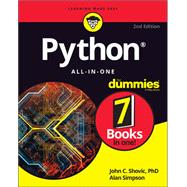The one-stop resource for all your Python queries
Powerful and flexible, Python is one of the most popular programming languages in the world. It's got all the right stuff for the software driving the cutting-edge of the development world—machine learning, robotics, artificial intelligence, data science, etc. The good news is that it’s also pretty straightforward to learn, with a simplified syntax, natural-language flow, and an amazingly supportive user community. The latest edition of Python All-in-One For Dummies gives you an inside look at the exciting possibilities offered in the Python world and provides a springboard to launch yourself into wherever you want your coding career to take you.
These 7 straightforward and friendly mini-books assume the reader is a beginning programmer, and cover everything from the basic elements of Python code to introductions to the specific applications where you'll use it. Intended as a hands-on reference, the focus is on practice over theory, providing you with examples to follow as well as code for you to copy and start modifying in the "real world"—helping you get up and running in your area of interest almost right away. This means you'll be finishing off your first app or building and remote-controlling your own robot much faster than you can believe.
- Get a thorough grounding in the language basics
- Learn how the syntax is applied in high-profile industries
- Apply Python to projects in enterprise
- Find out how Python can get you into hot careers in AI, big data, and more
Whether you're a newbie coder or just want to add Python to your magic box of tricks, this is the perfect, practical introduction—and one you'll return to as you grow your career.








